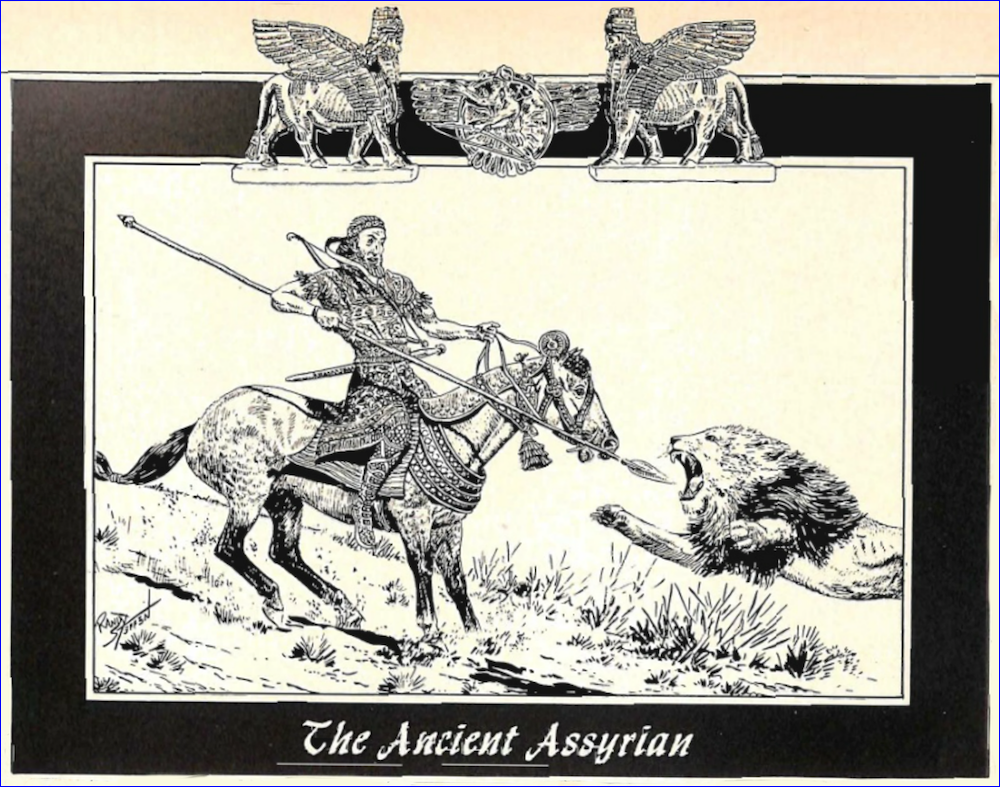


Animal life in ancient Assyria was as varied as the climate. Here roamed lions, tigers (now extinct in this part of the world), bear, leopards, hyenas, jackals, wild boar, and less fearsome hoofed members of the deer and antelope family. Truly, this land was a hunter's paradise... and therefore a paradise for Assyrians, for they were great hunters!
According to Xenophon, the Assyrian horse was -- for speed, symmetry, and power -- fully the equal of the modern Arabian. From the beginning of recorded time, the chief wealth of the native tribes of Southern Assyria was their horses. Traveling kings and princes gratified their pride and ambition by purchasing (sometimes at fabulous figures) the beautiful horses of the Mesopotamian and Arabian wastes. The Assyrian horses are smaller in size than the heavier breeds of Europe, but of "exquisite symmetry of form and grace of movement." (Xenophon)
The ancient Assyrians were a people of extraordinary valor. Everywhere in the art preserved from these ancient times man is seen in heroic action. He battles with the soldiers of enemy armies; he grapples in hand-to-hand combat with the lion, and the tiger, and the wild bull. This character of the Assyrian was especially shown in war. The same ferocity they showed in the pursuit and killing of wild animals they also exhibited in hunting men.
A typical Assyrian, Tiglath-Pileser, who ruled Assyria from 1130 B.C. to 1110 B.C., was one of that empire's greatest hunters... as well as quite a soldier. According to ancient inscription translations this mighty king led adventures that would make an ordinary man's hair stand on end. "Wild cattle had he pursued with his arrows. Nearly a thousand lions had he destroyed while going to and fro on his conquests. Some
creatures of the mountains and plains he had confined in cages and dragged back, bound in thongs, to his capitol. There did the royal keepers show them alive as the indubitable proof of the king's prowess and of the favor of Nin and Nergal, who gave the advantage in conflict, and guided the royal arrow in its flight."
My drawing shows what might have happened when Tiglath-Pileser finally persuaded a lion to charge him. The details of equipment were taken from a carving from an ancient Assyrian temple, supposedly showing Tiglath-Pileser in action. Costume and equipment are exact... if the royal sculptor who carved the base relief in stone knew what he was doing. While, at first glance, the heavily ornamented straps and tassels may look like pure ornamentation, there was method in their decoration. The heavy cheeks and diagonal straps across the horse's face do afford some protection against slashing swords... or claws. The heavy leather neck crest, with its cumbersome-looking throat and neck straps, would help turn the edge of a battle axe or a chopping sword blow... and would help fend off the raking teeth and claws of a lion who reached horse and rider in spite of a yard or more of steel or bronze in his gizzard. And the multiple studded collars around the horse's neck and shoulders should be effective in keeping arrows and lances from his vitals.
Notice the bit... a sort of snaffle, with reins attached to the ring, and headstall attached to an ornamented projection from the long cheek attached to the bar, or mouthpiece. Saddles were not in use in ancient times. One or more ornamental pads or blankets, held in place on the horse's back by a bellyband or surcingle, formed the seat for the rider. There were no stirrups in use for more than a thousand years after Tiglath-Pileser's time... at least not to my knowledge... so ancient horsemen had to be horsemen to accomplish the deeds they did horseback.
In this drawing Tiglath-Pileser is about to rein his war horse to the left just before the instant of impact of his spear with the lion. If all goes well, the horse will spin 45 degrees to the left on his hind feet, and the lion's raking claws will miss him. Notice that ol' Tiglath's pretty well protected against fangs and claws, too. His legs are encased in a metal fish scale armor, and there's also a shirtwaist of the same caliber under that fancy embroidered shirt he's sporting. His sword is handy in case the spear doesn't hit a vital spot; but according to this king's record of over a thousand lions to his credit, I'll bet the old boy had lion-sticking down to a pretty fine art!
This article was originally published in the February 1955 issue of Western Horseman as part 2 of the "Horsemen Through Civilization" series.

or register to post a comment.